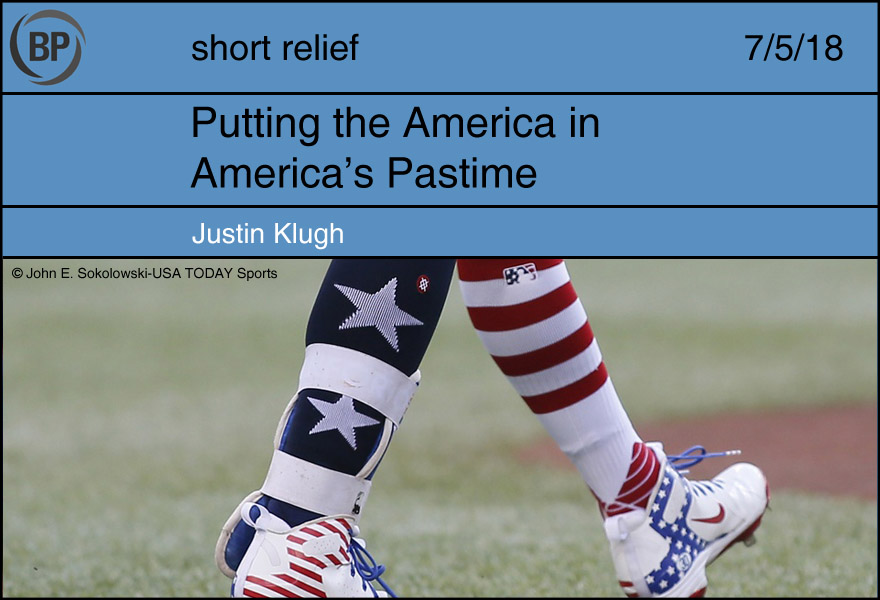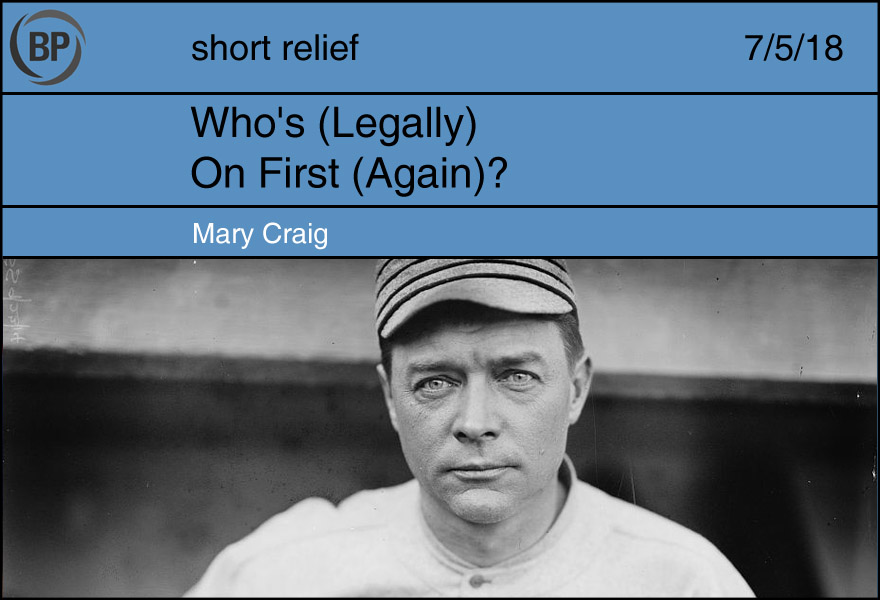
All right, gang. It’s officially summer. And what is it that kids love most about baseball?
“Chris Russo shrieking into a camera–”
That’s right: America. So this Independence Day, we’re pulling out all the stops. Stars and stripes on the hats. Stars and stripes on the arm sleeves. Stars and stripes on the catching gear. Stars and stripes on the baseballs. Use the same factory that sold us the weightlessness serum.
[Nodding]
Let’s talk match-ups. Kids are screaming it in the streets: “Give us a 16-inning Rays-Marlins game; almost a full doubleheader for the soul of Florida baseball.” After that, it’s primetime, baby. I’m talking Yankees-Red Sox, all week, every week.
“Wait, every wee–”
Yankees-Red Sox on ESPN. Yankees-Red Sox on MLBN. Yankees-Red Sox on HGTV. Yankees-Red Sox playing in the background while Jake Tapper speaks solemnly about an errant drone strike. People startled awake in the morning in their beds. What’s that noise, they wonder. That’s right, it’s the fifth inning of a Yankees-Red Sox game, and they’re playing shortstop.
“So you’re saying we should kidnap peop–”
We have to dominate off the field, too. This is trade season, baby. Young people love spreading lies. Have you talked to a teen lately? Everything out of their mouth is a falsehood. “I’ll have the car back by nine.” “Mom’s boyfriend isn’t taller than you.” “No it’s not a good idea to go over there and aggressively introduce yourself to Dwayne.”
So let’s capitalize on that. I want rumors flying past people’s heads. I want analysts and insiders sharing information so ludicrous people think they’re having heat strokes. Sources? Who needs ‘um. I want “rival scouts.” I want “multiple people have told me…” The Player of the Week is going to be “an anonymous NL executive.” Adrian Beltre to the Phillies. J.T. Realmuto to the Diamondbacks. Manny Machado to the Rays… front office. Darin Ruf hitting clean-up for the Yankees. I don’t care if he’s built a happy life for himself overseas. He signed a blood oath in this very office.
“Seriously? In his own bloo–”
Next, brawls. We need more of them. Nobody has to get hurt. Just shoving, uniform pulling, the screaming of a few nonsense words. We’ve got a couple of rivalries somewhere, right? How ‘bout, uh–Twins-Orioles. Imagine, Chris Davis vs. whoever’s pitching for Minnesota. Who’s it going to be? TBD? Well, let’s make sure he
“Won’t that–”
I don’t think it undermines the integrity of the game at all. Let’s get out there.
[Phillie Phanatic leans in with a crate of illegal fireworks under each arm]
Yeah. There’s more under my desk, have at it.

It was a baffling play to almost everyone witnessing it, one that would become a fixture in debates about baseball for decades. Yet for Philadelphia Athletics first baseman Harry Davis, it was perfectly obvious. The winning run was on third but the batter at the plate was unlikely to bring him home, so it was up to Davis himself to secure the victory. Having stolen second base without drawing a throw, he slowly tested the waters, immediately returning to first, also without drawing a throw. Feeling secure in his abilities, he stole second again, signaled to the runner on third to break for home, and ran back to first, this time drawing the throw and allowing the runner to score.
The play sent the opposing team into an uproar as the players and manager claimed that Davis was out as soon as he touched first the second time. Davis, however, asserted that he had merely legally stolen first base as there was no explicit rule outlawing the play. The umpire, who had also never seen such a play, waffled several times on his ruling depending on which team was yelling at him, first declaring that Davis was out before finally asserting that it was a tag play and Davis was therefore safe at first.
Though no other major league players attempted to steal first after Davis had done so, the concept reared its head repeatedly throughout the ensuing two decades. By the mid-1910s, the general consensus was that baseball games were too slow and pitchers were entirely too dominant, producing lengthy low-scoring affairs few people were interested in watching. Various solutions were proposed, from adding more rubber to the ball’s core to eliminating the foul strike, but none hung around quite like the idea of stealing first.
First re-introduced a decade after Davis had done it, the idea gained little traction and was generally thought of as untenable. However, as the game remained unchanged in the ensuing years, the advocates of this method grew more vocal. Not only would it speed up the game, they insisted, it would add to its overall excitement in giving the batter “a greater chance against the modern specialized pitcher.”[1] Aiding this cause was a wide reprint in 1917 of the events of Davis’s steal, which piqued the public’s curiosity, most notably that of Kansas City lawyer, Newton C. Gilham.
In early 1918, Gilham wrote to Boston Braves’ president, Percy Haughton, arguing the case for legalizing stealing first. After receiving no reply from Haughton, Gilham returned to the drawing board, spending the next four years fine-tuning his case before presenting it to Commissioner Kenesaw Mountain Landis in February of 1922. This version asserted the small but key point that allowing players to steal first was the only way to properly balance the “ins and outs” of this “strictly scientific game,” a conclusion Gilham had reached only after “conversing” with high-ranking MLB figures.
Gilham’s revamped argument stirred something in Landis that it had not in Haughton. The Commissioner promptly responded to Gilham’s letter, arguing that Gilham’s argumentation was lacking as it was wholly unclear how stealing first would speed up the game or even be possible to accomplish. With this two-sentence statement, the two-decade argument was laid to rest, and Gilham was free to return to more useful pursuits.
[1] Cincinnati Enquirer, February 16, 1922, pg. 10.
Thank you for reading
This is a free article. If you enjoyed it, consider subscribing to Baseball Prospectus. Subscriptions support ongoing public baseball research and analysis in an increasingly proprietary environment.
Subscribe now